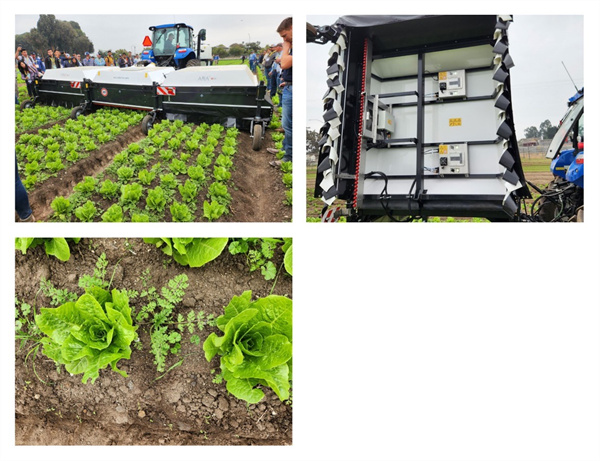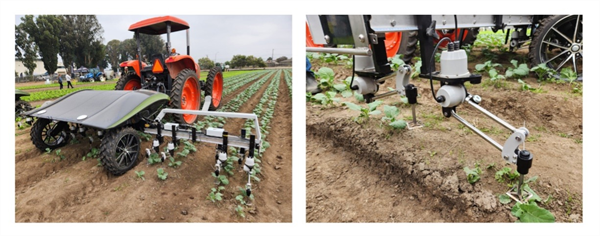
This study was conducted at the Yuma Valley Agricultural Center. The soil was a silty clay loam (7-56-37 sand-silt-clay, pH 7.2, O.M. 0.7%). Spinach ‘Meerkat’ was seeded, then sprinkler-irrigated to germinate seed Jan 13, 2025 on beds with 84 in. between bed centers and containing 30 lines of seed per bed. All irrigation water was supplied by sprinkler irrigation. Treatments were replicated four times in a randomized complete block design. Replicate plots consisted of 15 ft lengths of bed separated by 3 ft lengths of nontreated bed. Treatments were applied with a CO2 backpack sprayer that delivered 50 gal/acre at 40 psi to flat-fan nozzles.

Downy mildew (caused by Peronospora farinosa f. sp. spinaciae)was first observed in plots on Mar 5 and final reading was taken on March 6 and March 7, 2025. Spray date for each treatments are listed in excel file with the results.
Disease severity was recorded by determining the percentage of infected leaves present within three 1-ft2areas within each of the four replicate plots per treatment. The number of spinach leaves in a 1-ft2area of bed was approximately 144. The percentage were then changed to 1-10scale, with 1 being 10% infection and 10 being 100% infection.
The data (found in the accompanying Excel file) illustrate the degree of disease reduction obtained by applications of the various tested fungicides. Products that provided most effective control against the disease include Orondis ultra, Zampro, Stargus, Cevya, Eject .Please see table for other treatments with significant disease suppression/control. No phytotoxicity was observed in any of the treatments in this trial.
At the 2023 FIRA USA Robotics and Autonomous Farming Solutions Forum last month, some of the latest automated and robotic technologies were demonstrated in the field. Several of the weeding technologies demonstrated are brand new to the U.S. and/or Yuma, AZ area. These included a 5.6 inch2 (2.4 x 2.4 inch) resolution fixed boomed spot sprayer (Fig. 1), a high precision, “turret gun” spot sprayer (Fig. 2) and a mechanical weeder that utilizes a unique rotating blade design and lidar for depth control (Fig. 3). Although the test runs were short, I was impressed with the performance and possibilities of these machines. Company representatives said that they would be traveling to Arizona for the season and would like to meet with growers interested in their technology. Company contact information can be found at their respective websites, or feel free to contact me if you would like additional information.

Fig. 1. Ecorobotix1 (Yverdon-les-Bains, Switzerland) precision weeding machine
demonstration at 2023 FIRA USA. The unit has modular, 6.6’ wide spray booms
equipped with 156 individually controllable spray nozzles to spot spray weeds
(top right). A vision system is used to detect weeds and spot spray resolution is
2.4 x 2.4 inches. Darker soil indicates where spray (water) was delivered to
targeted weeds (bottom).

Fig. 3. GreenTech Robotics’ Weed Spider1 (Kelvin Grove, New Zealand)
demonstration at 2023 FIRA USA. The unit is equipped with a vision system for
detecting crop plants and weeds, and blades that move in and out of the crop row
to remove in-row weeds. Lidar sensors are used to create a 3-D image of the soil
surface and control cultivating blade depth.
It is reported that the herbicidal activities of Plant Growth Regulators (PGRs) were discovered in the 1940’s. Then, investigators in England and in the United States started their research on this type of herbicides1.
Some of these substances are hormones produced naturally by the plants and other are synthetically produced. Examples of naturally occurring growth regulators are gibberellins, auxin, cytokinin. Some stimulate stem elongation and cell elongation. One of the first synthetic selective herbicides developed is 2, 4-D (2,4-dichlorophenoxiacetic acid).
PGRs are used extensively for broadleaf weed control in grass crops in this region such as grain production, bermudagrass, alfalfa, cole crops, sugarbeet, forages, and turf grasses. These herbicides upset the natural balance of the hormones that controls cell division, cell enlargement, protein synthesis, and respiration. That is why this group of herbicides is sometimes called the “hormone herbicides”2. In our area growers are very careful using these products due to volatility with our summer temperatures and the problems caused to sensitive crops.
According to a report from Texas A&M “phenoxy growth regulator herbicides are reported to have the least plant activity and soil residual activity; the carboxylic acids generally have the most. Broadleaf crops and turf grasses should not be planted into soils recently treated with these herbicides because they severely inhibit seedling emergence”2.
Some PGRs:
|
Family |
Common Name |
Trade Name |
|
phenoxy |
2,4-D |
Pasture pro, others |
|
2,4-DB |
Butyrac |
|
|
MCPA |
Rhonox |
|
|
MCPP |
Several names |
|
|
benzoic acid |
dicamba |
Banvel |
|
carboxylic acid |
Picloram |
Tordon 22K |
|
Clopyralid |
Stinger |
|
|
triclopyr |
Remedy |
|
|
quinclorac |
Facet |
Results of pheromone and sticky trap catches can be viewed here.
Corn earworm: CEW moth counts down in all traps over the last month; about average for December.
Beet armyworm: Moth trap counts decreased in all areas in the last 2 weeks but appear to remain active in some areas, and average for this time of the year.
Cabbage looper: Moths increased in the past 2 weeks, and average for this time of the season.
Diamondback moth: Adults increased in several locations last, particularly in the Yuma Valley most traps. Below average for December.
Whitefly: Adult movement remains low in all areas, consistent with previous years
Thrips: Thrips adult movement continues to decline, overall activity below average for December.
Aphids: Winged aphids still actively moving but declined movement in the last 2 weeks. About average for December.
Leafminers: Adult activity down in most locations, below average for this time of season.